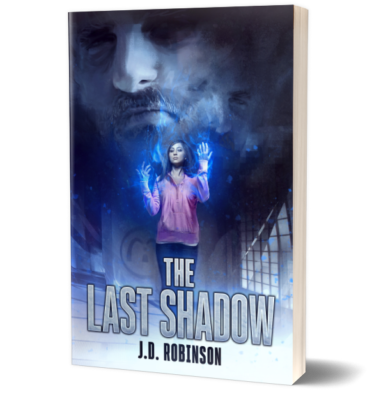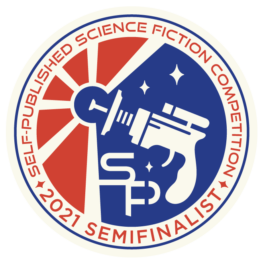The Last Shadow
The woman in the alley scratches a symbol into the pavement, then vanishes from the video. Now her desperate father is begging Bas Milius to accept one last case.
In 1991, strange things are afoot in Boston. Bas is on the verge of hanging up his hat, until his final client—the missing woman’s father—suddenly claims to be someone else entirely. Someone without a daughter.
Across town, Dee Khalaji finds herself having visions of someone watching a strange video in the shadows—a tape whose recording changes each time it’s played.
In a luxurious downtown compound, behind a door with a strange symbol on the front, a secretive couple offers shelter to lost souls. But their daily dance rituals aren’t for therapy alone, and the very first tape in their extensive surveillance collection features someone Bas lost nearly a decade ago.
A man on a mission to put the pieces together. A nonverbal autistic girl with the ability to see through others’ eyes. A story of identity, connection, and magic set in a Boston that never was.
Chapter 11
“Iris Quigley?”
The slight woman standing beside the Peabody Museum’s admissions desk blinked up at Bas, her momentary surprise masked by a smile.
“Bas Milius,” he said. Her hand disappeared into his as they shook. “I wanted to thank you for seeing me on such short notice.”
“I hope I can help you,” she said, ushering him back toward a staff office. “You’ll have to pardon the mess—we’re in the middle of transferring artifacts to archival boxes, so it’s been hectic.”
They entered the office, and Iris shut the door behind them. She motioned for him to sit before taking her own seat behind a desk.
“We spoke yesterday, didn’t we?” she asked.
“We did.” Bas didn’t know what else to say.
“Private investigator.”
“That’s right.”
“Well I have to say, that’s a first. This is already the most interesting part of my day.”
“And what’s your… uh, role here?”
“I am the Peabody Museum Editor for Anthropological Literature.”
Bas’s face grew warm. He was definitely wasting this woman’s time. Well, no need to draw it out. He patted his pockets until he felt the telltale crinkle of paper. “How much did Mr. Hartnett tell you about my visit?”
“Not a whit,” she said.
Bas laid the scrap of paper on her desk and smoothed it out for her. She leaned forward for a closer look.
“I was searching for the origin of this symbol at the Patent and Trademark Depository a couple days ago, and… do you know Ruth Hansen?”
Iris shook her head.
“Well, she mentioned that this might be an ethnic symbol of some kind.”
Iris’s brow furrowed as she reoriented the symbol, looking at it from several angles. Finally she sat back in her chair. “Well I can kind of see what she meant, if she was thinking about adinkras. But …” She shook her head. “No, this isn’t one of those.”
Adinkras?
“Is this the best copy you have?” Iris asked. “It’s hard to tell from a sketch.”
Bas shook his head. “This is actually my sketch of another sketch.”
Squinting, Iris reached over again covered part of the symbol with her hand. “If you were to cut this in half…” But instead of finishing her thought, she stood. “Here, let’s look together.”
She led him from her office, through a small crowd of guests, and down a flight of stairs to the basement. The air temperature dropped as they entered an open area as large as a ballroom, but with an unusually low ceiling. A myriad of painted wooden masks lay on a long table beneath dim lights. A young woman—a student perhaps—looked up as they entered, then returned to her notes. Toward the back of the room, towers of shelves held collected objects of every shape and size, from pottery to skulls. It reminded Bas of the BPD evidence room, only with fewer weapons and cash bundles.
Iris whisked around the shelves to a cabinet of drawers. A sign above them read, African Ethno. Coll. Beneath that was a long catalog number.
Iris pulled out the top drawer and consulted an index, tracing her finger down the list. Then she slid the drawer back, scanned the labels next to the drawer pulls, and pulled out another drawer. Inside lay an oversized book. She opened it, revealing thin yellowed pages filled with diagrams and simple geometric forms. They looked hand-drawn.
“Okay, this is what I was thinking of,” she said.
“That word you said earlier?” Bas said. “Adinkas?”
“Adinkras. Yes, that’s what these are. They originated in West Africa, and were used in a pre-literate context to represent complex concepts.”
Bas scanned the symbols. “I’m not seeing a match.”
She gestured at him. “Let’s see your sketch again?”
He brought out his scrap and handed it to her.
She laid it on the page. “Right, so watch.” She put her hand over the base of the sketch. “Now imagine the top part mirrored below.”
Bas imagined what she was suggesting. The ‘M’ became something more like an infinity symbol with a flared nodule at the center. One of the symbols on the adinkras page was almost an exact match.
“It’s like this one,” Bas said, pointing. “Right? Kind of.”
“It’s closer than I thought, actually,” Iris said. “Yours has a kind of ‘i’ punched out of the middle bar, but it’s similar enough to look intentional.”
Bas read the inscription printed just below the symbol. “This is the symbol for hope?”
“Well, yes, but there’s more to it.” Iris handed the scrap of paper back to Bas and turned to the next page in the book. Smaller versions of the same symbol were laid out in a single column here, with information next to each. “These glyphs aren’t just sounds or words. They’re like proverbs. So this one’s full meaning…” She pointed to one of the blurbs and leaned back to let Bas read.
“O God, something is in heaven, let it come into my hand.” Bas straightened, turning the phrase over in his head. “I guess that would be a kind of hope.”
“Or depending on your reading of it, maybe a bit Promethean?”
“Hm.” Bas’s idle hand pinched his empty pocket. What did stealing from the gods have to do with a woman’s hasty drawing in an alleyway?
“Does this help with your investigation?” Iris asked, hands resting on the edge of the drawer.
Bas sighed. “Honestly, I don’t know. Is there anything else you can tell me?”
She pursed her lips. “Not without more context, I’m afraid. With a corpus of imagery, we could apply configurational or ethnological analyses, but with just this… you can’t rule out that your symbol is a one-off, a doodle with no symbolic meaning at all.”
That couldn’t be true. Bas thought back to Cynda’s ritualistic movements. The symbol wasn’t an afterthought—it was part of a ceremony.
Iris was eyeing him curiously. “Can I ask where you saw this symbol?”
As they strolled back toward the basement steps, Bas gave her an overview of the ritual on the security video. He left out the parts about Cynda’s father and her apparent disappearance.
“You know,” said Iris, who had listened intently, “there’s some debate that use of symbols during rituals may even predate Homo sapiens.” Her voice was quieter now, as if she was speaking off the record. “But it brings to mind a panel I attended at a conference last year, on interpretive anthropology. You wouldn’t think… ” She laughed, shaking her head.
“What?” Bas was barely following her, but he was desperate for leads, and this symbol was all he had to go on.
“I’m not one to get woo-woo.”
“Go for it,” Bas said.
“Well, the discussion centered around two schools of thought when it comes to symbols, and what symbols mean. Especially with regard to abstract symbols in magic cultures, like Wicca.”
Bas nodded. Was she talking about witchcraft?
“To boil it down,” she continued, “you have the symbol-reference view and the symbol-link view. Symbol-reference suggests that a symbol is just a reference to its meaning with no other connection than that.”
“So, basically the way we think of any symbol? Like a logo.”
“That’s right. But the other view, the symbol-link view, sees the symbol as a kind of a gate or window. In that case the sign itself might possess a direct connection to its meaning, and bring about certain actions in the physical world.”
Bas hoped she couldn’t see his arm hairs standing on end.
“Do you really believe that?” he asked after several seconds. “Because, I have to say, that’s intensely woo-woo.”
Her smile just then was a welcome sight.
“I’m saying that’s what that the woman in your video footage may have believed.” She shrugged. “It may be something to file away.”

Genre: Science Fiction
Published: 2020
Cover design: Bastien Lecouffe Deharme (site)
Note: Affiliate links on this page provide me a commission for qualifying purchases at no cost to you.
Get The Last Shadow
Buy directly
View retailers
“
★★★★★ You are transported into a world where your expectations are turned upon their head. A superb read. If I had a hat, I’d tip it.
-N. Snape, Science Fiction author
It’s all wonderfully woven together in a sort of modern day film noire supernatural detective story. Great read!
-Charles H., reviewer
All at once this is science fiction, a novel about family and loss, a detective story and a bit of a thriller. Amazingly, you made this all work.
-Lorelei M., beta reader
The Last Shadow was honored as a semifinalist in the SPSFC’s vaunted SF competition in 2021!
